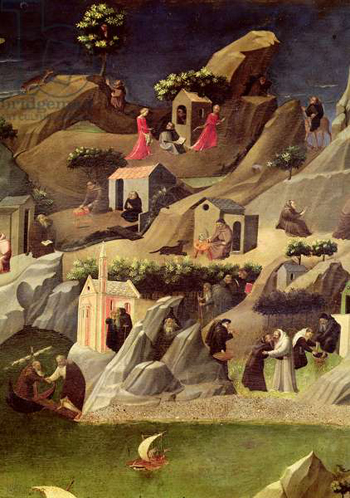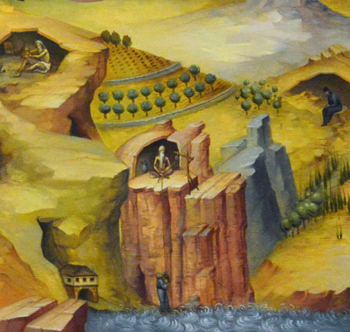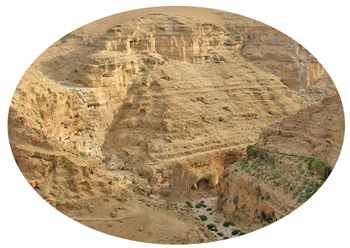World History
 |
 |
 |
 |
 |
 |
 |
The Desert Monks - I
The Hermits Populated the Deserts of Egypt
We have all heard of the Desert Fathers, those hermit monks who, following the shining prototype St. Anthony of the Desert (251-356), retired to the wilderness to offer their lives to God as solitaries in prayer and sacrifice. The rush to the desert got underway in the 4th century, and soon there were enormous numbers of monks. By 390, when the persecutions had long ceased, there were over 50,000 solitaries – men as well as women – in just the Desert of Nitria, one of the three major centers of Christian monastic activity in the East.
The selection below is from the Historia Monachorum, an early source for 4th century Egyptian monasticism. The anonymous author, who was a monk in Jerusalem, travelled to the deserts of Egypt and reported on the monks there.
What he found amazed him: not just solitary monks in isolated hermitages, but large communities of monks, some living under the guide of one master, others in smaller communities, some dedicated solely to prayer but others hiring themselves out for service to maintain the community and to provide for the poor. Everywhere he was edified by the virtue, courtesy and hospitality of those desert dwellers.
Below, we will follow him in a short part of his travels where he described the different lifestyles of the desert monks.
In the country round about Arsinöe, we saw a certain Serapion, a priest and the father of many monasteries. Under his care he had more than 10,000 monks, in many and diverse groups, and all of them earned their bread by the work of their hands. The greater part of what they earned, especially at harvest time, they brought to this Father for the use of the poor.The selection below is from the Historia Monachorum, an early source for 4th century Egyptian monasticism. The anonymous author, who was a monk in Jerusalem, travelled to the deserts of Egypt and reported on the monks there.
What he found amazed him: not just solitary monks in isolated hermitages, but large communities of monks, some living under the guide of one master, others in smaller communities, some dedicated solely to prayer but others hiring themselves out for service to maintain the community and to provide for the poor. Everywhere he was edified by the virtue, courtesy and hospitality of those desert dwellers.
Below, we will follow him in a short part of his travels where he described the different lifestyles of the desert monks.

By the 5th century the Nitria Desert was populated with communities of monks
And so we came to Nitria, the place most famous among all the monasteries of Egypt, about 37 miles distant from Alexandria and named after the neighboring town where nitre (potassium nitrate) is collected, as if in the Providence of God it was foreseen that in these places the sins of men would be washed and utterly effaced, even as stains are cleansed by nitre.
In this place there are about 50 habitations, set near together and under one Father. In some of these many brethren live together, in some a few, and in others a brother lives alone. But though they be divided in their dwelling, yet do they abide bound and inseparable in spirit and faith and loving kindness.
So then, as we were drawing near the place, as soon as they knew that strange brethren were coming, straightway they poured out like a swarm of bees, each from his cell and ran to meet us, joyous and eager. Most were carrying pitchers of water and bread, because the Prophet rebuking certain folk had said, "Ye come not forth to meet the children of Israel with bread and water." ...
But of their humanity, their courtesy, their loving kindness, what am I to say, when each man of them would have brought us into his own cell, not only to fulfill the duty of hospitality, but still more out of humbleness, of which they are indeed masters, and from gentleness and its kindred qualities which are learned among them with diverse grace but one and the same doctrine, as if they had come apart from the world for this same end. ...

Deep in the desert were the solitaries who lived completely remote from any society
One by one they abide in their cells, a mighty silence and great quiet among them. Only on Saturday and Sunday do they come together to church, and there they see each other face to face as folk restored in heaven.
If by chance any one is missing in that gathering, they understand that he has been detained by some malady of his body, and straightway they all go to visit him: Not indeed all of them together but at different times, and each carrying with him whatever he may have by him in his cell that might seem helpful to the sick.
But for no other cause dare any disturb the silence of his neighbor, unless perchance to strengthen by a good word, as it might be to anoint with the comfort of counsel the athletes set for the struggle.

Hidden in the mountains of Nitria are the caves of past monks

Based upon Anonymous, The Desert Fathers, trans. Helen Waddell,
New York: Sheed & Ward, 1942, pp. 70-74.
Posted July 20, 2018
______________________
______________________
 Volume I |
 Volume II |
 Volume III |
 Volume IV |
 Volume V |
 Volume VI |
 Volume VII |
 Volume VIII |
 Volume IX |
 Volume X |
 Volume XI |
 Special Edition |


